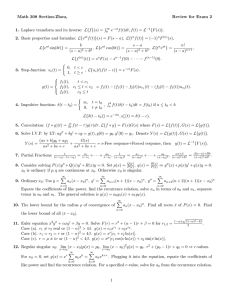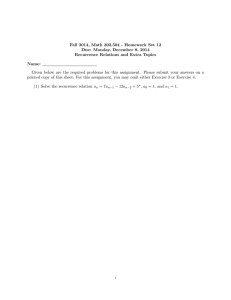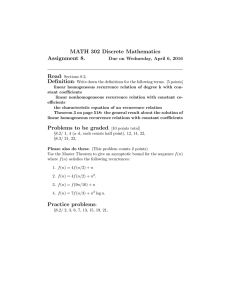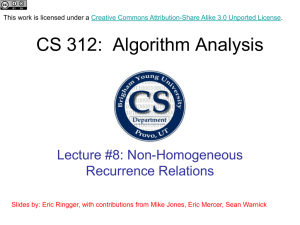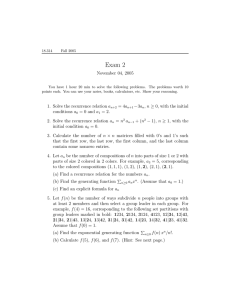Non-homogeneous RRs
advertisement
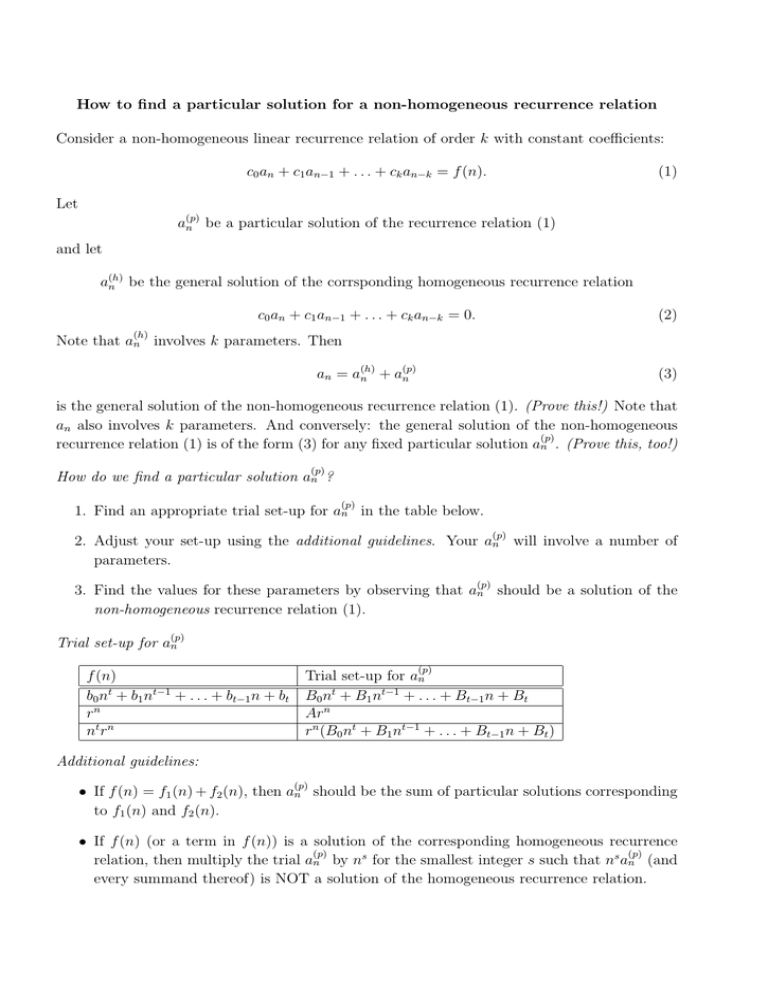
How to find a particular solution for a non-homogeneous recurrence relation Consider a non-homogeneous linear recurrence relation of order k with constant coefficients: c0 an + c1 an−1 + . . . + ck an−k = f (n). (1) Let a(p) n be a particular solution of the recurrence relation (1) and let a(h) n be the general solution of the corrsponding homogeneous recurrence relation c0 an + c1 an−1 + . . . + ck an−k = 0. (2) (h) Note that an involves k parameters. Then (p) an = a(h) n + an (3) is the general solution of the non-homogeneous recurrence relation (1). (Prove this!) Note that an also involves k parameters. And conversely: the general solution of the non-homogeneous (p) recurrence relation (1) is of the form (3) for any fixed particular solution an . (Prove this, too!) (p) How do we find a particular solution an ? (p) 1. Find an appropriate trial set-up for an in the table below. (p) 2. Adjust your set-up using the additional guidelines. Your an will involve a number of parameters. (p) 3. Find the values for these parameters by observing that an should be a solution of the non-homogeneous recurrence relation (1). (p) Trial set-up for an f (n) b0 nt + b1 nt−1 + . . . + bt−1 n + bt rn nt r n (p) Trial set-up for an B0 nt + B1 nt−1 + . . . + Bt−1 n + Bt Arn rn (B0 nt + B1 nt−1 + . . . + Bt−1 n + Bt ) Additional guidelines: (p) • If f (n) = f1 (n) + f2 (n), then an should be the sum of particular solutions corresponding to f1 (n) and f2 (n). • If f (n) (or a term in f (n)) is a solution of the corresponding homogeneous recurrence (p) (p) relation, then multiply the trial an by ns for the smallest integer s such that ns an (and every summand thereof) is NOT a solution of the homogeneous recurrence relation. Example 1. Consider the second-order non-homogeneous linear recurrence relation with constant coefficients an = aan−1 + ban−2 + f (n) with characteristic roots r1 = 2 and r2 = 5. Depending on f (n), we seek a particular solution in the following form: f (n) 3 5n2 − 3n + 2 (6n2 + 1) · 3n 5 · 2n 5 · 2n + 6 · 3n 5 · 2n + 6 · 5n (p) Set-up for an A An2 + Bn + C (An2 + Bn + C) · 3n A2n · n An2n + B · 3n An2n + Bn5n Example 2. Consider the second-order non-homogeneous linear recurrence relation with constant coefficients an = aan−1 + ban−2 + f (n) with a double characteristic root r1 = r2 = −2. Depending on f (n), we seek a particular solution in the following form: f (n) 3 5n2 − 3n + 2 6 · 3n 5 · (−2)n 5n · (−2)n 5n2 · (−2)n (p) Set-up for an A An2 + Bn + C A · 3n A(−2)n · n2 (An + B)(−2)n · n2 (An2 + Bn + C)(−2)n · n2 2
